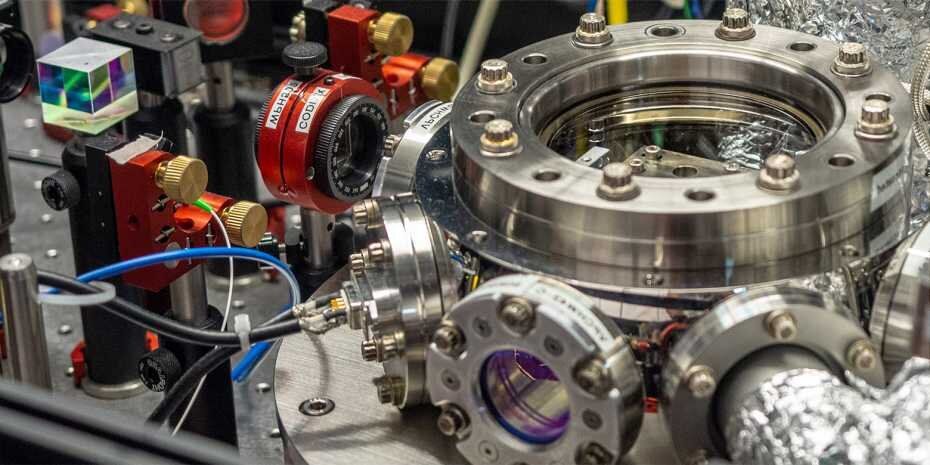Page 8821
Apr 25, 2019
Researchers Just Measured an Atom with a Half-Life of 18 Sextillion Years
Posted by Quinn Sena in categories: cosmology, particle physics
Deep inside a mountain in central Italy, scientists are laying a trap for dark matter. The bait? A big metal tank full of 3.5 tons (3,200 kilograms) of pure liquid xenon. This noble gas is one of the cleanest, most radiation-proof substances on Earth, making it an ideal target for capturing some of the rarest particle interactions in the universe.
It all sounds vaguely sinister; said Christian Wittweg, a doctoral candidate at the University of Münster in Germany, who has worked with the so-called Xenon collaboration for half a decade, going to work every day feels like “paying a Bond villain a visit.” So far, the mountain-dwelling researchers haven’t captured any dark matter. But they recently succeeded in detecting one of the rarest particle interactions in the universe. [11 Biggest Unanswered Questions About Dark Matter]
According to a new study published today (April 24) in the journal Nature, the team of more than 100 researchers measured, for the first time ever, the decay of a xenon-124 atom into a tellurium 124 atom through an extremely rare process called two-neutrino double electron capture. This type of radioactive decay occurs when an atom’s nucleus absorbs two electrons from its outer electron shell simultaneously, thereby releasing a double dose of the ghostly particles called neutrinos.
Continue reading “Researchers Just Measured an Atom with a Half-Life of 18 Sextillion Years” »
Apr 25, 2019
Researchers transmit data via a semiconductor laser, opening the door to ultra-high-speed Wi-Fi
Posted by Quinn Sena in category: internet
You’ve never heard Dean Martin like this.
Researchers from the Harvard John A. Paulson School of Engineering and Applied Sciences transmitted a recording of Martin’s classic “Volare” wirelessly via a semiconductor laser—the first time a laser has been used as a radio frequency transmitter.
In a paper published in the Proceedings of the National Academy of Sciences, the researchers demonstrated a laser that can emit microwaves wirelessly, modulate them, and receive external radio frequency signals.
Apr 25, 2019
Fake Meat Startup Beyond Meat Says It’s Worth More Than $1 Billion
Posted by Quinn Sena in category: food
Plant-based fake meat startup Beyond Meat has announced plans to go public sometime in early May, according to CNN. And based on the company’s plans, the public offering will likely value Beyond Meats at an impressive $1.2 billion.
That’s an extraordinary upswing — in addition to selling its increasingly-trendy meat alternative on grocery store shelves, the company recently partnered with both Carl’s Jr. and Del Taco, which could explain how the company is headed toward a coveted “unicorn” valuation.
Apr 25, 2019
Surgeons Just Sent a Tiny, Autonomous Bot Into a Heart Valve
Posted by Quinn Sena in categories: biotech/medical, robotics/AI
In a world first, surgeons just used a self-navigating surgery robot in an experimental surgery — training a robotic catheter to find its way to a leaky valve in a pig’s heart.
The new robot, described in research published in the journal Science Robotics on Wednesday, marks the beginning of the transition from robotic surgical tools to true robot-assisted surgeries, where autonomous devices can actually take the load off of overburdened human doctors.
Apr 25, 2019
A breakthrough in the study of laser/plasma interactions
Posted by Quinn Sena in categories: biotech/medical, supercomputing
A new 3D particle-in-cell (PIC) simulation tool developed by researchers from Lawrence Berkeley National Laboratory and CEA Saclay is enabling cutting-edge simulations of laser/plasma coupling mechanisms that were previously out of reach of standard PIC codes used in plasma research. More detailed understanding of these mechanisms is critical to the development of ultra-compact particle accelerators and light sources that could solve long-standing challenges in medicine, industry, and fundamental science more efficiently and cost effectively.
In laser-plasma experiments such as those at the Berkeley Lab Laser Accelerator (BELLA) Center and at CEA Saclay—an international research facility in France that is part of the French Atomic Energy Commission—very large electric fields within plasmas that accelerate particle beams to high energies over much shorter distances when compared to existing accelerator technologies. The long-term goal of these laser-plasma accelerators (LPAs) is to one day build colliders for high-energy research, but many spin offs are being developed already. For instance, LPAs can quickly deposit large amounts of energy into solid materials, creating dense plasmas and subjecting this matter to extreme temperatures and pressure. They also hold the potential for driving free-electron lasers that generate light pulses lasting just attoseconds. Such extremely short pulses could enable researchers to observe the interactions of molecules, atoms, and even subatomic particles on extremely short timescales.
Supercomputer simulations have become increasingly critical to this research, and Berkeley Lab’s National Energy Research Scientific Computing Center (NERSC) has become an important resource in this effort. By giving researchers access to physical observables such as particle orbits and radiated fields that are hard to get in experiments at extremely small time and length scales, PIC simulations have played a major role in understanding, modeling, and guiding high-intensity physics experiments. But a lack of PIC codes that have enough computational accuracy to model laser-matter interaction at ultra-high intensities has hindered the development of novel particle and light sources produced by this interaction.
Continue reading “A breakthrough in the study of laser/plasma interactions” »
ETH researchers have cooled a nanoparticle to a record low temperature, thanks to a sophisticated experimental set-up that uses scattered laser light for cooling. Until now, no one has ever cooled a nanoparticle to such low temperatures in a photon cage. Dominik Windey and René Reimann – a doctoral student and postdoc in the group led by Lukas Novotny, Professor of Photonics – have succeeded in cooling a 140 nanometre glass bead down to a few thousandths of a degree above absolute zero.
The researchers recently published details of their work in the journal Physical Review Letters. Their breakthrough came in the form of a sophisticated experimental set-up involving optical tweezers, whereby a nanoparticle can be made to levitate with the aid of a laser beam. The group has already used the same optical tweezers in previous work, in which they caused a nanoparticle to rotate around its own axis at extremely high speed.
Apr 25, 2019
Extracting something from nothing: A bright glow from empty space
Posted by Quinn Sena in categories: nuclear energy, particle physics, quantum physics
Particles travelling through empty space can emit bright flashes of gamma rays by interacting with the quantum vacuum, according to a new study by researchers at the University of Strathclyde.
It has long been known that charged particles, such as electrons and protons, produce the electromagnetic equivalent of a sonic boom when their speeds exceed that of photons in the surrounding medium. This effect, known as Cherenkov emission, is responsible for the characteristic blue glow from water in a nuclear reactor, and is used to detect particles at the CERN Large Hadron Collider.
According to Einstein, nothing can travel faster than light in vacuum. Because of this, it is usually assumed that the Cherenkov emission cannot occur in vacuum. But according to quantum theory, the vacuum itself is packed full of “virtual particles”, which move momentarily in and out of existence.
Continue reading “Extracting something from nothing: A bright glow from empty space” »
Apr 25, 2019
Building a printing press for new quantum materials
Posted by Quinn Sena in categories: computing, encryption, nanotechnology, quantum physics
Checking out a stack of books from the library is as simple as searching the library’s catalog and using unique call numbers to pull each book from their shelf locations. Using a similar principle, scientists at the Center for Functional Nanomaterials (CFN)—a U.S. Department of Energy (DOE) Office of Science User Facility at Brookhaven National Laboratory—are teaming with Harvard University and the Massachusetts Institute of Technology (MIT) to create a first-of-its-kind automated system to catalog atomically thin two-dimensional (2-D) materials and stack them into layered structures. Called the Quantum Material Press, or QPress, this system will accelerate the discovery of next-generation materials for the emerging field of quantum information science (QIS).
Structures obtained by stacking single atomic layers (“flakes”) peeled from different parent bulk crystals are of interest because of the exotic electronic, magnetic, and optical properties that emerge at such small (quantum) size scales. However, flake exfoliation is currently a manual process that yields a variety of flake sizes, shapes, orientations, and number of layers. Scientists use optical microscopes at high magnification to manually hunt through thousands of flakes to find the desired ones, and this search can sometimes take days or even a week, and is prone to human error.
Once high-quality 2-D flakes from different crystals have been located and their properties characterized, they can be assembled in the desired order to create the layered structures. Stacking is very time-intensive, often taking longer than a month to assemble a single layered structure. To determine whether the generated structures are optimal for QIS applications—ranging from computing and encryption to sensing and communications—scientists then need to characterize the structures’ properties.
Continue reading “Building a printing press for new quantum materials” »
Apr 25, 2019
Long live Nemo! New animal model in aging research?
Posted by Quinn Sena in categories: biotech/medical, genetics, life extension
The colorful Clownfish lives longer than 20 years in the aquarium. Researchers of the Scuola Normale Superiore in Pisa, Italy, in collaboration with the Leibniz Institute on Aging (FLI) in Jena, Germany, have investigated the genetics behind the longevity of clownfish. By sequencing the genome and comparing the sequences with other species, they were able to show, that the secret of this longevity lies in the mitochondria and lysosomes of the clownfish. Because it is uncomplicated to keep and breed clownfish, they represent an interesting new animal model for research on longevity. The results are now published in the journal BMC Evolutionary Biology.
Clownfish, famous because of the Disney movie “Finding Nemo,” are a bright orange-white-black colored fish with three vertical stripes, which occur in the western Pacific and Indian Oceans. Clownfish live in symbiotic relationship with sea anemone. They are reliant on sea anemone for shelter in their natural habitat, which offer protection for the fish with its tentacles. The Clownfish’s mucus protection prevents it from being stung by the tentacles of the sea anemone. Thanks to this survival strategy, clownfish have a lower mortality rate than other fishes and can grow quite old. Until now there was not much known about the lifespan of this interesting sea dweller.

















